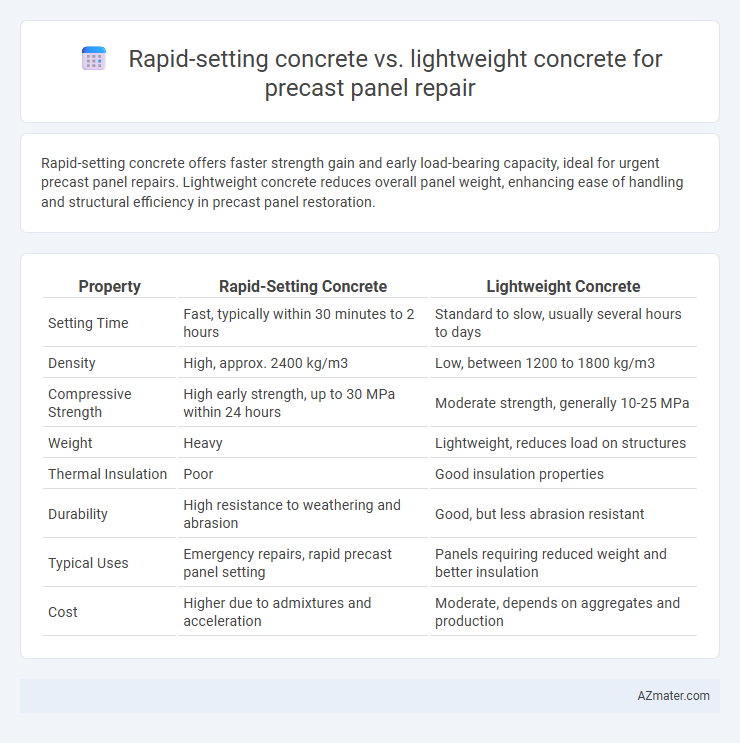Rapid-setting concrete offers faster strength gain and early load-bearing capacity, ideal for urgent precast panel repairs. Lightweight concrete reduces overall panel weight, enhancing ease of handling and structural efficiency in precast panel restoration.
Table of Comparison
| Property | Rapid-Setting Concrete | Lightweight Concrete |
|---|---|---|
| Setting Time | Fast, typically within 30 minutes to 2 hours | Standard to slow, usually several hours to days |
| Density | High, approx. 2400 kg/m3 | Low, between 1200 to 1800 kg/m3 |
| Compressive Strength | High early strength, up to 30 MPa within 24 hours | Moderate strength, generally 10-25 MPa |
| Weight | Heavy | Lightweight, reduces load on structures |
| Thermal Insulation | Poor | Good insulation properties |
| Durability | High resistance to weathering and abrasion | Good, but less abrasion resistant |
| Typical Uses | Emergency repairs, rapid precast panel setting | Panels requiring reduced weight and better insulation |
| Cost | Higher due to admixtures and acceleration | Moderate, depends on aggregates and production |
Introduction to Precast Panel Repair
Precast panel repair requires materials that ensure structural integrity and minimize downtime. Rapid-setting concrete offers accelerated curing times ideal for quick repairs, while lightweight concrete reduces load impact and improves thermal insulation in panels. Selecting the appropriate material depends on the repair's urgency, structural demands, and performance criteria specific to precast panels.
Overview of Rapid-Setting Concrete
Rapid-setting concrete offers accelerated curing times, enabling repairs on precast panels to be completed within hours rather than days, significantly reducing downtime. Its high early strength development and resistance to weathering make it ideal for emergency repairs and structural restorations. This concrete type incorporates specialized cementitious materials and admixtures tailored to achieve quick hardness without compromising long-term durability.
Overview of Lightweight Concrete
Lightweight concrete, composed of lightweight aggregates such as expanded clay, shale, or pumice, offers enhanced thermal insulation and reduced structural load for precast panel repair applications. Its lower density improves handling and reduces transportation costs while maintaining adequate compressive strength for durable repairs. The material's porous structure also provides improved fire resistance and acoustic performance compared to rapid-setting concrete alternatives.
Key Differences Between Rapid-Setting and Lightweight Concrete
Rapid-setting concrete cures quickly within 30 minutes to a few hours, enabling faster repairs and minimizing downtime, while lightweight concrete offers lower density and improved thermal insulation but cures over a standard time frame of 24 to 48 hours. Rapid-setting concrete boasts high early strength and durability, making it ideal for urgent precast panel repairs, whereas lightweight concrete emphasizes reduced weight and enhanced workability, beneficial for structural load reduction. The choice depends on repair timelines and performance requirements, with rapid-setting concrete suited for immediate load application and lightweight concrete preferred for long-term structural advantages.
Strength and Durability Considerations
Rapid-setting concrete offers high early strength development, enabling faster turnaround times in precast panel repair projects where minimizing downtime is critical. Lightweight concrete provides enhanced durability through reduced shrinkage and improved thermal insulation, though it generally achieves lower compressive strength compared to traditional rapid-setting mixes. For applications requiring a balance of strength and longevity, the selection depends on specific structural load demands and environmental exposure conditions.
Installation and Curing Time Comparison
Rapid-setting concrete for precast panel repair offers significantly reduced installation and curing times, often achieving initial set within 30 minutes and allowing structural use in 1 to 3 hours, enabling faster project turnaround and minimal downtime. Lightweight concrete typically requires longer curing periods, ranging from 24 to 72 hours for adequate strength, although it reduces dead load and improves thermal insulation. Choosing rapid-setting concrete enhances repair efficiency in time-sensitive applications, whereas lightweight concrete is preferable when weight reduction and long-term durability are priorities.
Weight Impact on Precast Panel Structures
Rapid-setting concrete offers significant advantages in precast panel repair due to its high early strength gain and reduced downtime, but it typically has a higher density, adding considerable weight to the structure. Lightweight concrete features a lower density, often ranging between 1,200 to 1,800 kg/m3, compared to traditional concrete's 2,400 kg/m3, substantially reducing the overall weight of precast panels and lessening structural load. Choosing lightweight concrete mitigates stress on supporting frameworks and foundation systems, enhancing durability and performance in repair scenarios where weight is a critical factor.
Thermal and Acoustic Properties
Rapid-setting concrete provides superior thermal insulation due to its dense matrix, which reduces heat transfer in precast panel repairs, while lightweight concrete offers enhanced acoustic properties by absorbing sound waves through its porous structure. The low thermal conductivity of rapid-setting concrete minimizes energy loss, making it ideal for exterior panel applications requiring quick turnaround. Lightweight concrete's cellular composition effectively dampens noise, improving sound insulation in interior panels or environments with high acoustic demands.
Cost Analysis and Budget Implications
Rapid-setting concrete offers faster curing times, reducing labor costs and minimizing downtime in precast panel repairs, which can lead to overall budget savings despite its higher material price. Lightweight concrete provides cost benefits through reduced transportation and handling expenses due to its lower density, though it may require longer curing periods, potentially increasing project duration costs. Selecting between the two requires balancing immediate material costs with labor efficiency and long-term structural performance to optimize repair budgets effectively.
Best Applications and Recommendations
Rapid-setting concrete is best suited for precast panel repairs requiring quick turnaround times, such as emergency structural fixes and fast-track construction projects, due to its fast strength gain and early load-bearing capacity. Lightweight concrete is recommended for applications where reducing the overall panel weight is critical, like in high-rise buildings or retrofitting existing structures to decrease seismic loads, because of its lower density and improved thermal insulation properties. Selecting between the two depends on the repair priorities: rapid-setting concrete for speed and early strength, lightweight concrete for reduced weight and enhanced durability.

Infographic: Rapid-setting concrete vs Lightweight concrete for Precast panel repair
 azmater.com
azmater.com